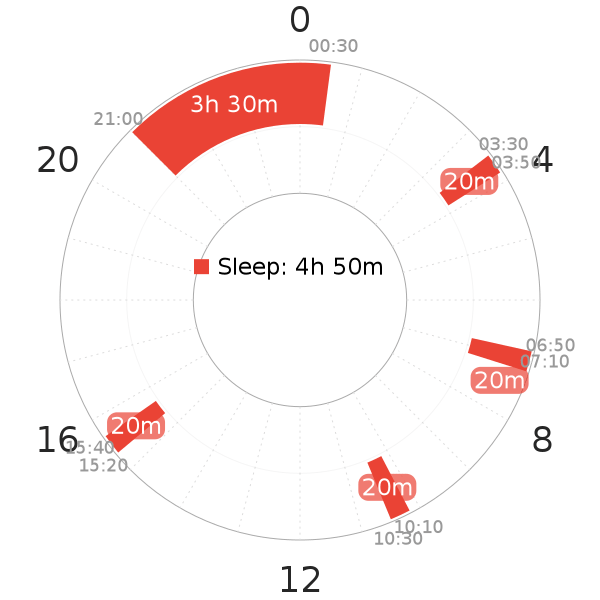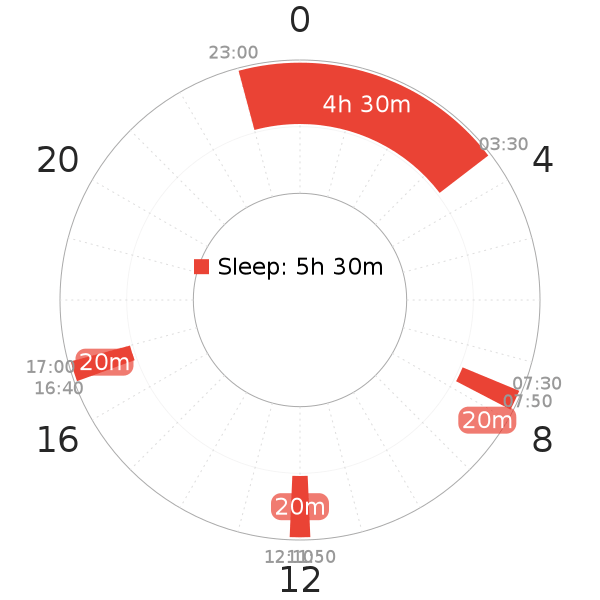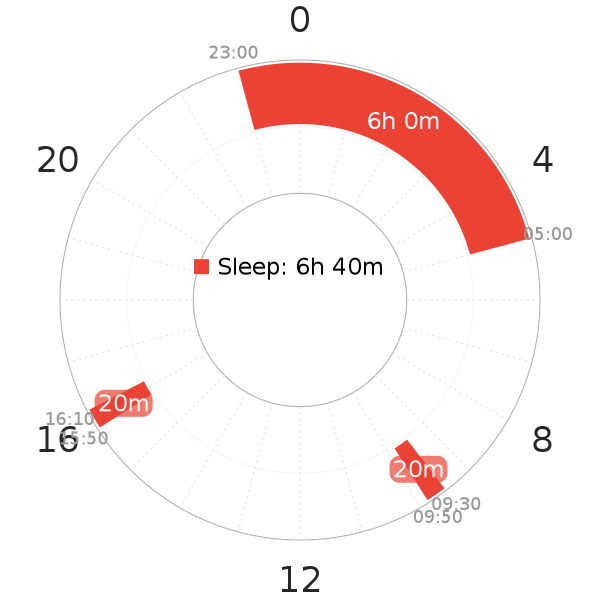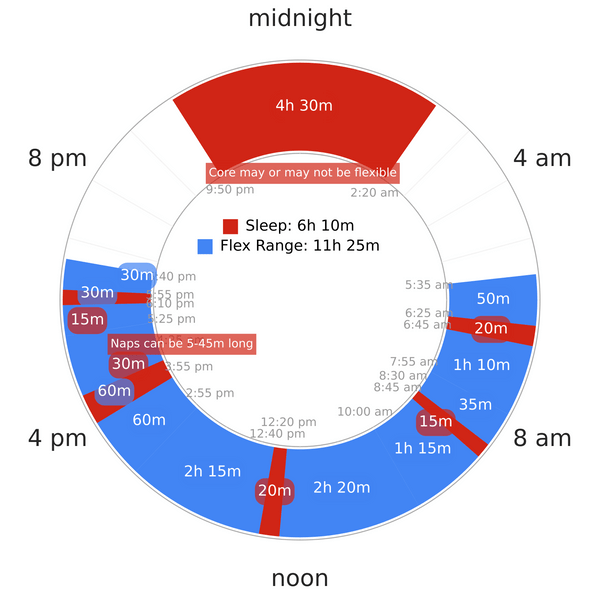
The name SEVAMAYL is an abbreviation of “Sleep Everyman As Much As You Like”. Because of an inability to adapt to this schedule cold turkey, adaptations are very rare. All of the twenty or more known attempts to adapt to a type of flexible, variable Everyman without prior standard adaptation have failed.
Strict Everyman adaptations, however, have been successfully followed by flexed versions with a handful of community members in recent years. The ability to move naps assists with a hectic, changing lifestyle.
- The individual needs to develop a clear sense of their level of tiredness to take naps at the ideal times.
- The proper nap times will optimally sustain wakefulness as well as get the needed REM sleep.
- Most early naps contain REM sleep, however, later naps will typically only contain light sleep and don’t need to be as frequent.
The main purpose of this schedule is to work around a flexible lifestyle that other polyphasic schedules cannot accommodate. The main challenge is the need to control your schedule for over a month in order to adapt to a strict base schedule first, before being able to adapt to SEVAMAYL.
Content
- Lifestyle
- Why Does It Work?
- Adapted Feelings
- Alternate Variants
- Adaptation Strategies
For what lifestyles is this schedule best?
SEVAMAYL fits those with erratic schedules, but is also possible to utilize with strict lifestyles. However when used on a strict work schedule, SEVAMAYL loses its purposes. If that is the case, a strict schedule or an Everyman schedule with slightly flexed nap times, but no variation in nap number or length may be more appropriate.
Research
Interested in a literature source on SEVAMAYL? Click here.
Why Does This Schedule Work?
After a rigid Everyman-schedule has been adapted to, the brain has replaced its standard sleeping schedule and adjusted to a reduced sleep total. The new schedule then contains SOREM naps and highly repartitioned cores. Then, it is possible to shift this schedule without reducing sleep quality, as opposed to flexing during the adaptation.
Because the naps are flexible, they will most likely contain a lower amount of REM than the naps of the strict schedule. This may require an extra nap to give the same total REM sleep. Still, the core has covered a significant amount of REM, the main purpose of the naps is to alleviate homeostatic pressure.
It is also possible to utilize Pronaps to more efficiently fulfill the REM need; one would need fewer naps later in the day.
What Does It Feel Like Once Adapted?
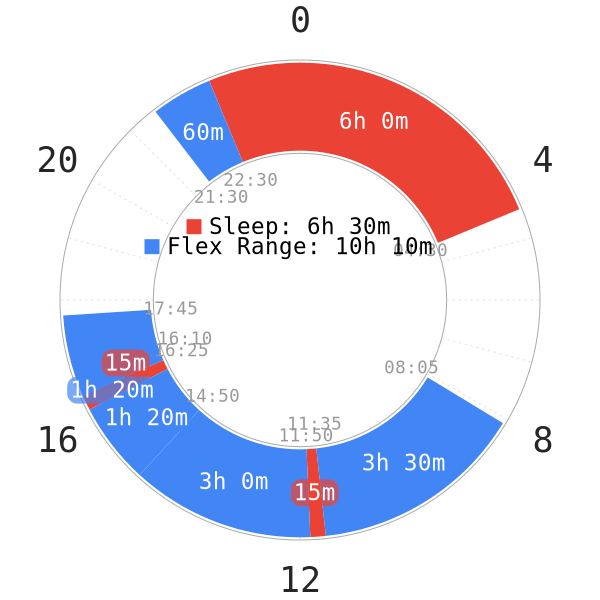
- Once adapted, it is possible to occasionally increase or decrease the length of the core by 90 minutes.
- Nap amounts can increase or decrease to help offset the tiredness.
- After this shortened- or lengthened core, sleepers should return to the previously adapted core duration to allow the core to remain stable. Core extension should NOT be more often than once a week.
As is the case with other schedules, quality naps give a large boost to alertness around the clock. The freedom given by this schedule is also very fulfilling.
What Variations of SEVAMAYL Actually Work?
A couple notes about SEVAMAYL’s core and nap relationships:
- The core length of SEVAMAYL can be from 4.5 hours in length to no upper limit. The core length might naturally decrease to about 4 hours if it compress in length; this is also observable in certain polyphasic schedules. However, this should not be expected until after many weeks.
- Some people might be able to adapt to a 3.5 hour long core, but it is unclear at this point if the flexibility is great enough; in addition, all attempts have failed so far.
- There need to be at least 6 equivalent monophasic cycles on the intermediate Everyman schedule for SEVAMAYL to be adaptable; meanwhile, there are usually 5 equivalent monophasic cycles on the standard schedules. This refers to one quality REM nap effectively replacing one nighttime 90m core cycle in terms of rejuvenation power.
- While SEVAMAYL does not have a fixed number of naps, the naps still represent the intermediate Everyman schedule. For example, if E3-extended is the intermediate schedule, then SEVAMAYL is going to have more naps than E2-extended as an intermediate schedule. This is because the fewer core cycles there are, the more REM sleep the naps should provide.
- The core should be during the night, and the scheduling range depends on the variant of SEVAMAYL:
| Core length | Start of core, scheduling range |
| 3.5 hours | 21 – 22 |
| 4.5 hours | 20 – 02 |
| 6 hours | 20 – 02:30 |
What is the Best Adaptation Strategy?
Up to this point in time, there have been no successful cold turkey adaptations to SEVAMAYL. There have certainly been attempts, however all of them have failed. This is because the sleep pressure from shortening the total sleep time is not great enough to force the naps to repartition, as is the case with most schedules.
SPAMAYL on the other hand, has no core to partially take care of the sleep pressure, leading to the naps forcefully becoming entrained.
- It is necessary to start a SEVAMAYL adaptation only after successfully adapting to a rigid schedule first, through gradual adaptation.
- After an adaptation to the rigid schedule has been complete for at least a month, sleepers can start a flexing adaptation.
- Then, they can escalate to varying nap length and possibly even core placements. Each increase in nap flexibility of about 30-60 minutes takes a couple weeks to adapt to. Flexing naps just 10-15 minutes more takes up to a week to adapt to. While adapting to flexible naps, large periods of time will be unpredictably drowsy around those original nap times.
- Since SEVAMAYL has such a high flexibility, the standard Everyman-schedules are not going to suffice as the first adaptation step; extended versions would be necessary.
Core Duration
- The most common intermediate adaptation step is E3-extended; however, E2-extended is also possible for a 6-hour core SEVAMAYL.
- E4-extended should work for people with sleep requirements on the lower side; yet, it is unclear how flexible a mere 3.5 hour long core will be on an adapted SEVAMAYL.
- There are only reports of a few successful E3-flex sleepers where one or two naps were a bit flexible, but otherwise required strict timing.
- A 3-hour core will likely not work. When comparing the raw nap flexibility of 3 hour versus 3.5 hour core E3, the difference is massive. The 3-hour core schedules have nearly no flexibility at all.
| E4-extended | E3-extended | E2-extended |
http://napchart.com/dhczt |
A flexing adaptation is not going to look like a regular adaptation to a polyphasic schedule. It is going to require continuous monitoring and adjusting of sleep times.
- First, adapt to a rigid schedule for about a month to 6 weeks. This bears repeating because it appears to be an essential step.
- Then, the best way to complete a flexing adaptation to SEVAMAYL is to start flexing, or shifting, nap times by 10 to 15 minutes from the rigid point. One or two naps become flexible at a time.
- The shifting can be done either with just flexing or by flexing and adding a nap, until the alertness levels have risen back up and stabilized.
- A 10-15 minute shift should take roughly 3 to 4 days to adapt to for each nap; however, this can take up to a week.
- After this step is complete, the flexing length of the rigid point increases, one or two naps at a time.
- After naps are refreshing despite being slightly flexible, flexing can increase in larger jumps. This range can increase by 30-60 minutes each direction, and then up to 2 hours in each direction for each nap.
- Occasionally add a nap during unusually long wake periods to get used to a variable nap number.
- The nap times should after this point be alterable according to the feeling of homeostatic pressure. This also makes way for duties that change times.
Nap Mechanics
- During the adaptation to polyphasic schedules, some people will start waking up after around 12 to 15 minutes into a nap.
- When this is the case, the best approach is to attempt to salvage 5 or more minutes of the nap by returning to sleep.
- Normally these premature wakes last for a few days to a few weeks, but eventually stop occurring. However, on SEVAMAYL there is no need to return to sleep after a premature wake.
- If you wake up before your alarm, the best strategy is to get up.
- However, returning to sleep for the full duration of the nap will yield more wakefulness sustaining. What this means is that it is useful to sleep for the full duration of the nap if one’s schedule requires a long gap of wakefulness ahead.
- The premature wakes from the naps is the main reason why they are 15 minutes long on the standard SEVAMAYL schedule, which is the average nap length.
- It is also normal for naps during the later parts of the day to shorten in length, while early naps stay 20 minutes long. Certain naps in the day (out of REM peak) can also lengthen to ~30m occasionally.
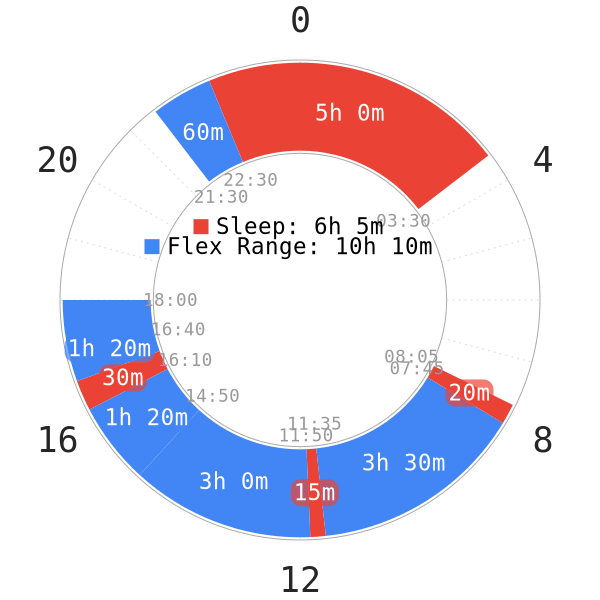
- Recently, there have been successful adaptations to SEVAMAYL with occasional extension of a nap after adaptation. One sleeper from the Discord has demonstrated that this is possible.
- He occasionally extends a nap duration from 20m to 30m when a bit more tired than usual.
- This serves to garner more recuperative values from the longer nap; meanwhile, his default nap duration is still 20m for all naps.
- Alternatively, during emergency, a nap can shorten down to ~5m, with however many naps as possible.
These open even more versatility in nap duration of SEVAMAYL after adaptation. This also leads back to the importance of the ability to listen to one’s own body when attempting this schedule.
Delaying a nap may increase desire to sleep, but once adapted will have no effect on performance, alertness, or general feeling of well-being until it’s delayed excessively. Perhaps longer than an hour or two in the morning, or delayed longer than 2-4 hours in the evening.
If you can anticipate that day’s busy times, you can plan an extra nap before as well as delaying the default nap much later.
Core Sleep Mechanics
It is also possible to learn to flex the core sleep. It is going to be harder to do than flexing the naps, but the process is going to be the same.
- The placement of the core is shifted in small increments from the rigid point until alertness levels have returned to the high standards. Then, the process repeats with a larger range.
- It should be possible to learn to flex the start of the core by as much as 90 minutes with this method; however, it takes longer than adapting to flexed naps. 30 minutes of core flex (e.g. 10:30pm or 11:30pm instead of 11pm) should be comfortable and realistic. This should take a week or two to adapt to.
- One can also flex the core while flexing the nap(s). However, it is unwise to take both to extremes at the same time.
It is important to plan your day so that you can reach a suitable napping spot when it is time for a nap. It is also necessary to also watch food intake and exercise to protect the naps’ quality.
SEVAMAYL is in some ways the holy grail of polyphasic sleep.
- It is a reduced sleep total that saves many hours every week, while also maximizing alertness all day,
- No need to stick to any strict sleep times.
- Its versatility in scheduling and usage also shines if necessary short-term.
Notes on Downsides
- The adaptation takes many weeks and a lot of persistence.
- It is also mandatory to first establish more efficient sleep using a strict base schedule. That means life and sleep has to be controllable for up to about 6 weeks, before you can start attempting SEVAMAYL.
- Then, be prepared for as many as 7-9 additional weeks of adaptation to SEVAMAYL.
- SEVAMAYL’s adaptation mostly revolves around Stage 4, feeling “almost” but not quite refreshing or stable. Risk of oversleep remains, even as natural wakes become frequent.
While SEVAMAYL is more resilient in flexibility, it’s also prone to many of the same breakdowns as regular polyphasic schedules.
- Excess sleep due to illness, extreme emotional distress, or falling out of habit during a long vacation with monophasic sleepers can pose serious threats.
- Severe injury or excessive flexing can also cause too many oversleeps and undo adaptation.
Main author: Crimson & GeneralNguyen
Page last updated: 8 April 2021

